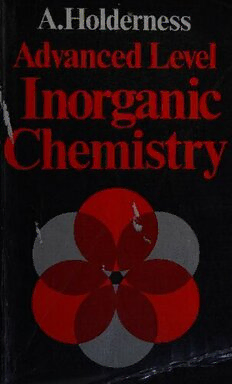
Advanced Level Inorganic Chemistry PDF
Preview Advanced Level Inorganic Chemistry
_ A.Holdeérness e t e e e ] Ss“ G&S Advanced Level Inorganic Chemistry Other books by A. Holderness Advanced Level Physical Chemistry Intermediate Organic Chemistry Ordinary Level Revision Notes in Chemistry Revision Notes in Advanced Level Chemistry Volume One: Organic Chemistry Volume Two: Inorganic Chemistry Volume Three: Physical Chemistry and in conjunction with J. Lambert A New Certificate Chemistry Graded Problems in Chemistry to Ordinary Level Worked Examples and Problems in Ordinary Level Chemistry Problems and Worked Examples in Chemistry to Advanced Level The Essentials of Qualitative Analysis The Essentials of Volumetric Analysis (with F. Sherwood Taylor) Advanced Level Inorganic Chemistry A. Holderness A new edition of the /norganic section of /norganic and Physical Chemistry revised by Martyn Berry,M.A., B.Sc., C.CHEM., F.R.I.C. Senior Teacher, Science, and Head of Chemistry, Chislehurst and Sidcup Grammar School and a companion to Advanced Level Physical Chemistry eI é > ‘% gat Niet’ Oo, Ws 8 NS Yo? NO, 2 ; : AZ 7 <> Heinemann Educational Books i, Oe London ae Heinemann Educational Books Ltd 22 Bedford Square, London WCIB 3HH LONDON EDINBURGH MELBOURNE AUCKLAND HONG KONG SINGAPORE KUALA LUMPUR NEW DELHI IBADAN NAIROBI JOHANNESBURG EXETER (NH) KINGSTON PORT OF SPAIN ISBN 0 435 65435 7 © A. Holderness 1961, 1963, 1979 First published as part of Inorganic and Physical Chemistry 1961 Reprinted 1962 Second Edition 1963 Reprinted 1964, 1966, 1967 Third Edition (Inorganic Chemistry section only) 1979 Typeset by Thomson Press (India) Ltd, New Delhi and printed in Great Britain by Richard Clay (The Chaucer Press) Ltd, Bungay Preface The subjects which we study do not have their boundaries defined by God but by men. We take the totality of experience and (for various excellent reasons) call some parts of it ‘science’. Science is divided, largely for the convenience of students, teachers, and users, into the disciplines of biology, physics, chemistry, and so on. Chemistry itself is further divided into the major areas of physical, inorganic, organic, and analytical chemistry. Those who practise and use science are crossing the barriers between subjects with increasing frequency and to increasing effect; for examples one has only to think of molecular biology and semi- conductors. The social and economic consequences of scientific activity transcend subject boundaries. But the boundaries and subdivisions still prove useful for the purposes of teaching and learning. This book is a new edition of the inorganic section of Albert Holderness’s Inorganic and Physical Chemistry. It uses, as any book on inorganic chemistry must do, very many of the ideas developed in the companion volume on physical chemistry (Advanced Level Physical Chemistry by A. Holderness, revised by J. N. Lazonby). It is assumed that this can easily be referred to by the reader, and there are frequent references in this text to the physical chemistry volume. It is always difficult to revise an established classic. Such is the pace of advance in chemical theory and practice that the new book has to incorporate discussion of ideas and techniques which were either totally unknown, or only dimly perceived, when the book was last revised. A conscious attempt has been made to retain as much as possible of the flavour and philosophy of the previous edition, while at the same time ensuring that the present work is a thoroughly up-to-date textbook. The material has been rearranged, and there have been major deletions and additions. SI units are used, and nomenclature is based on the recommendations of the Association for Science Education and the Examining Boards. This book contains rather more descriptive and preparative material than is customary in contemporary inorganic chemistry texts at Advan- ced and Scholarship level, while at the same time covering the syllabus requirements for a theoretical background. It is hoped that this will vi Preface enable the volume to be useful as a reference for both facts and ideas. I am very grateful to John Lazonby for his detailed and helpful criticism of the text. Any errors and imperfections which remain are solely my responsibility. I am also grateful to Graham Taylor, Hamish MacGibbon, and Katherine Ross of Heinemann Educational Books for much encouragement and help. Above all, I am grateful to my wife and children for putting up with me during a task which proved tougher and longer than I had bargained for. June 1979 Martyn Berry Important note All melting and boiling points are, unless otherwise stated, quoted for a pressure of 101 325 N m?. Where great accuracy is not essential, e.g. in industrial processes, pressures are often quoted in ‘atmospheres’, abbreviated to ‘atm’ (1 atm x 10°Nm?). Equations involving energy changes are written with the enthalpy change in the form (energy) x (amount of substance)~‘. The units for AH will thus be kJ mol~'. The use of ‘mol~ ” does not imply ‘per mole of any particular material formed or used up, but ‘per molar quantities as indicated by the equation,’ Hence, for example: CO(g) + 40,(g) > CO,(g) “AH = — 283 kJ mol7! 2CO(g) + O,(g) > 2CO,(g) AH = — 566kJ mol"! (See e.g. Cvitas and Kallay, Chemistry in Britain, June 1978, p. 290.) About the questions Most of the questions in this book are of the ‘essay’ type, although there are also many problems. Readers should remember that the chemistry examinations of an increasing number of Boards require an ability to cope with fixed response questions, usually in the form of an ‘objective test’ paper and a ‘structured’ paper. Considerations of space mean that there are no questions of these kinds in this book. Thanks are due to the Oxford Delegacy of Local Examinations(O), the University of Cambridge Local Examination Syndicate(C), the Joint Matriculation Board(JMB), the University of London University Entrance and Schools Examination Council(L), and the Associated Examination Board (AEB) for permission to reproduce questions.
